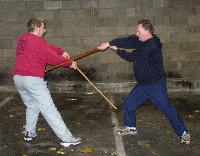|
|
 |
|||
|
Kempo is an extensive, but now fragmented, group of former martial crafts (bugei) and martial arts (bujutsu) that were disbanded in their original form before or around 1868. Ken means "fist" and/or "sword" depending on which Chinese character is used to write it, while Po means "method".
Today we just have fragments of the once more complete Kempo systems that went before. However, the former systems were so extensive that the surviving fragments still represent a huge body of methods. It has been said that Kempo enthusiasts are very much martial historians - they are the custodians of the last remnants of long dead martial crafts. It has often been suggested that the term "martial craftsman" rather than "martial artist" may thus be appropriate for the practitioners of Kempo. This is one example of Kempo not fitting into modern conceptions about martial arts - there are many. As a result of people's preconceptions about martial arts modern Kempo practitioners have tried a wide variety of terms to explain what they do, without much success - these include Karate (meaning "Chinese Hand", not "Empty Hand"), Japanese Kung-Fu, Japanese Kickboxing, Sword and Fist Method, Bujutsu, Tojutsu, and so on. The reality is that no short term can define Kempo because it must first overcome preconceptions about the nature of martial arts before conveying what Kempo is. Foremost among these preconceptions is the belief that Chinese and Japanese martial arts developed separately and are independent strands. This misconception is more a result of the social consequences of the modern Japanese occupation of large parts of China up to 1945 than it is of the historical reality of the feudal period during which the precursor arts of Kempo developed. A more accurate description of Kempo would be "Mostly Chinese martial arts conveyed to Japan prior to 1868 and/or Japanese martial that came under heavy Chinese influence prior to 1868; in both cases the formal schools (ryuha) that constituted these arts were disbanded before or around 1868". The significance of 1868 is that it marked the disbandment of the Samurai and the end of feudal rule in Japan. It should also be noted that more recently the term Kempo has also been used to refer to some martial arts that were imported to Japan well after 1868, including Karate, Taikyokuken, Taikiken, several kinds of Shorinji Kempo, and western-style boxing or kickboxing type of methods. Furthermore, older Kempo systems have been reformulated into new systems, categorised along with other modern arts as Gendai Budo, that are intended to meet modern needs or to hold over something of the past in a form that is acceptable in modern times. This latter type of Kempo is perhaps most famously represented by Nippon Kempo, but there are many other systems including Kaido Miwa Ryu Kempo, the style that we study. Modern martial arts, such Karate and Judo, have also been incorporated into some modern Kempo styles, and the term has in a few instances been used to refer to combinations of Karate and Judo without any prior Kempo style being incorporated. Rather than saying what Kempo is today, it is much easier to say what Kempo’s precursor arts were in former times. These had their heyday during the 14th, 15th and 16th centuries when the original purpose of this diverse group of crafts was political expediency, that is, they were used to train people whose job it was to maintain the political status quo in the Japan of that time. That basically meant keeping the ascendant Ashikaga clan and its many allied families in power, and helping to facilitate a healthy trade relationship with China that the early Ashikaga Shoguns tried hard to cultivate. Many of the Kempo precursor arts were based on the school of Shinto whose guardians were the Yoshida (formerly Urabe) family. This was not just coincidence, many of the Yoshida were supporters of the Ashikaga, and also it was found that the normal Zen training of the bushi (warriors) was not suitable for many of the kinds of political applications such as the "protection" of strategic members of important families to prevent them from becoming the focus of power groups, and counter-piracy to pacify the Chinese Emperors who had concerns about the Japanese pirates or Wako. So selected groups of bushi were instead trained in Yoshida Shinto, as well as in a wide diversity of methods from different martial arts schools (ryuha), which made them more effective in these "non standard" roles. |
|||
